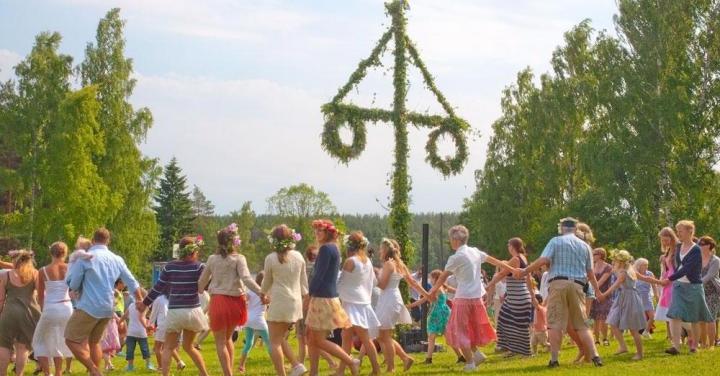Halloween stems from the ancient celebration of Samhain! In fact, many of today’s holidays—from Groundhog Day to Christmas—were originally seasonal markers. Discover the Quarter Days and the Cross-Quarter Days of the ancient Celtic calendar. Learn why we have elections in November, weddings in June, groundhog celebrations in February—and why we do what we do!
Advertisement
The Celtic Calendar
The timing of present-day rituals, traditions, and holidays was influenced by the ancient Celts:
- Their calendar year was divided into four seasons or major sections, marked by four Quarter Days.
- Then, each section was divided in half, creating four Cross-Quarter days.
For the ancient Celts, Cross-Quarter days signaled the beginning of a season! For example, what is now Groundhog Day (Candlemas) would be considered the start of spring.
Some historians are divided as to whether the ancient Celts observed the solstices and equinoxes (what we call Quarter Days). Some believe that the Celts divided the year into just four major sections: Samhain, Imbolc, Beltane, and Lughnasadh (what we call Cross-Quarter days). For this article, we will assume that the ancient Celts observed all eight divisions of the year.
Together, the Quarter Days and Cross-Quarter Days made an eight-part year that reflected the natural progression of the seasons.
The 4 Quarter Days
The days that marked the four major divisions of the year were called Quarter Days; they marked the solstice (when the sun sets at its most northern or southern point on the horizon) and equinoxes (when the sun sets due west). This fit readily into the rhythm of the ways people farmed.
As the 12-month Roman calendar was adopted for both civil and religious purposes, all of the Celtic days began to conform more closely with the liturgical year of the Christian church and became identified with major religious festivals.
March 25, Lady Day
Around the time of the spring equinox, Lady Day became the traditional day for hiring farm laborers for the planting and harvesting seasons ahead. (In the church calendar, this day became the feast of the Angel Gabriel’s annunciation to the Virgin Mary that she would be the mother of Christ.)
June 24, Midsummer Day
Around the time of the summer solstice, this day was the midpoint of the growing season, halfway between planting and harvest. (The English church later celebrated this day as the birthday of John the Baptist, who foretold the coming of Jesus. The feast day of the Nativity of St. John the Baptist is celebrated exactly six months before that of the celebration of Christ’s birth.) Folks celebrated by feasting, dancing, singing, and preparing for the hot summer days ahead. Learn more about Midsummer Day.
 Image: A Midsommar celebration in Stockholm, Sweden. ArtesiaWells/Getty Images
Image: A Midsommar celebration in Stockholm, Sweden. ArtesiaWells/Getty Images
September 29, Michaelmas
Around the time of the fall equinox, the harvest commenced on this day, and there were great fairs and festivals. This started the custom of early autumnal elections, because it was a convenient time for people to gather. Elections came to be shifted to November in the American climate, where the harvest season was more stretched out.
December 25, Christmas
This observance originated as a winter solstice festival and celebrated a time of resting and gathering fertility for a new round of sowing and reaping. The Celtic rituals merged easily with the Christian celebration of the birth of Jesus. Farm workers were usually paid for their year’s labor at Christmas, giving them reason to celebrate and three months rest before the next season.
The 4 Cross-Quarter Days
These days marked the midpoint between each solstice and equinox. For the ancient Celts, these signaled the beginning (not middle) of a season, with the major two divisions being winter (Samhain), starting the dark half of the year, and summer (Beltane), starting the light half of the year
February 2, Imbolc/Candlemas
Candlemas acquired its English name from the candles lit that day in churches to celebrate the presentation of the Christ Child in the temple of Jerusalem.
Originally, this day was called Imbolc (lambs’ milk) because the lambing season began. It was also called Brigantia for the Celtic female deity of light, calling attention to the Sun being halfway on its advance from the winter solstice to the spring equinox.
Much of this day is grounded in the seasons—estimating how soon spring-like weather will come and when to plant the crops.
- It was not held as a good omen if the day itself was bright and sunny, for that betokened snow and frost to continue to the hiring of the laborers 6 weeks later on Lady Day.
- If it was cloudy and dark, warmth and rain would thaw out the fields and have them ready for planting.
Our Groundhog Day is a remote survivor of that belief. Though we recognize animal behavior isn’t always the way to judge planting dates, the tradition continues, often with a wink and a smile.

May 1, Beltane/May Day
May Day, or Beltane, was the halfway point between the spring equinox and the summer solstice, and marked the beginning of summer for the ancient Celts. It was a day for dance and song to hail the sown fields starting to sprout.
May Day was a time for the pairing of young couples, although not yet for their wedding, which would not come until the Quarter Day which was called Midsummer Day (June 24). Midsummer is basically the same as the Summer Solstice, so there were approximately 6 weeks between May 1 and Midsummer for the couple to get to know each other.
Today, June is still one of the most popular months for weddings!
August 1, Lughnasadh/Lammas Day
Lammas (a corruption of the Old English words for “loaf mass”) was the midpoint between the summer solstice and autumnal equinox.
Traditionally a festival associated with harvesting grain, it marked the beginning of the wheat harvest, and especially celebrated the first wheat or corn crop. Grains harvested at Lammas time also include barley, oats, and sunflower. Tenant farmers would have presented the first crop harvest to their landlord.
- Lughnasadh was the wedding of the Sun god Lugh to the Earth goddess, causing the ripening of crops.
- The church transformed it into the “feast of first fruits.” Villages would take the first loaves of bread to the “loaf mass,” which became corrupted in pronunciation to “lammas.” The word lammas comes from the Old English hlaf, “loaf,” and maesse, “mass” or feast.”
- After the loaf was blessed, the farmers broke it into four pieces and placed each piece in the corners of their barn to protect the newly harvested grain. Lammas bread was often made in shapes including wheat, owls, and corn dolls.
Much lore is associated with this day, including this proverb: “After Lammas Day, corn ripens as much by night as by day.”
It was upon a Lammas night,
When corn rigs are bonie,
Beneath the moon’s unclouded light,
I held awa to Annie;
The time flew by, wi’ tentless heed,
Till, ‘tween the late and early,
Wi’ sma’ persuasion she agreed
To see me thro’ the barley.
–Robert Burns
The date is still celebrated in England, Scotland, Wales, Northern Ireland and other countries in the Northern Hemisphere by baking Lammas bread, making corn dollies, bundling twigs together and enjoying large feasts with friends and family.
October 31, Samhain/Halloween
Samhain (“summer’s end”) is celebrated as today’s Halloween. Many historians believe that it served as the start of the new year in the Celtic calendar—their “New Year’s Day.”
It was the day when the cattle were brought in from pasture; those needed for the winter’s supply of meat would be slaughtered. Since Samhain was the death-night of the old year, it came to be associated with ghosts and graveyards. During this dark time of year, it was believed that the spirits of the dead wandered from sunset until midnight. After midnight, the ghosts are said to go back to rest. (That day, November 1, later became All Saints’ Day.) Samhain has happier associations too, such as apple bobbing, which was a form of telling fortunes for the new year.
Read more about the fascinating origins of Halloween!
We hope you found this history interesting! It’s fascinating to us how our modern holidays reflect the rich fabric of our past.


 Image: A Midsommar celebration in Stockholm, Sweden. ArtesiaWells/Getty Images
Image: A Midsommar celebration in Stockholm, Sweden. ArtesiaWells/Getty Images








Comments